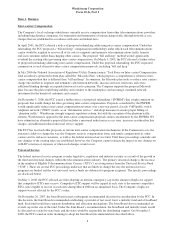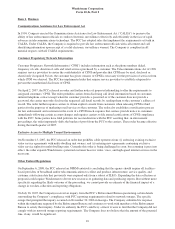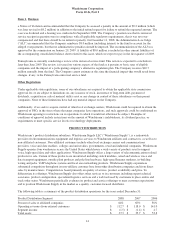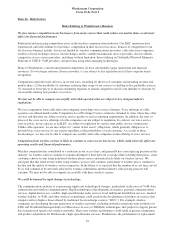Windstream 2008 Annual Report Download - page 64
Download and view the complete annual report
Please find page 64 of the 2008 Windstream annual report below. You can navigate through the pages in the report by either clicking on the pages listed below, or by using the keyword search tool below to find specific information within the annual report.
Windstream Corporation
Form 10-K, Part I
Item 1A. Risk Factors
Risks Relating to Windstream’s Business
We face intense competition in our businesses from many sources that could reduce our market share or adversely
affect our financial performance.
Substantial and increasing competition exists in the wireline communications industry. Our ILEC operations have
experienced, and will continue to experience, competition in their local service areas. Sources of competition to our
local service business include, but are not limited to, wireless communications providers, cable television companies,
resellers of local exchange services, interexchange carriers, satellite transmission service providers, electric utilities,
competitive access service providers, including, without limitation, those utilizing an Unbundled Network Elements-
Platform or UNE-P, VoIP providers, and providers using other emerging technologies.
Many of Windstream’s current and potential competitors (a) have substantially larger operational and financial
resources, (b) own larger and more diverse networks, (c) are subject to less regulation and (d) have superior brand
recognition.
Competition could adversely affect us in several ways, including (1) the loss of customers and resulting revenue and
market share, (2) the possibility of customers reducing their usage of our services or shifting to less profitable services,
(3) our need to lower prices or increase marketing expenses to remain competitive and (4) our inability to diversify by
successfully offering new products or services.
We may not be able to compete successfully with cable operators that are subject to less stringent industry
regulations.
We face competition from cable television companies providing voice service offerings. Voice offerings of cable
operators are offered mainly under Competitive Local Exchange Carrier certificates obtained in states where they offer
services and therefore are subject to fewer service quality or service reporting requirements. In addition, the rates or
prices of the voice service offerings of cable companies are not subject to regulation. In contrast, our voice service
rates or prices, in our capacity as an ILEC, are subject to regulation by various state public service commissions.
Unlike cable operators, we are also subject to “carrier of last resort” obligations, which generally obligates us to
provide basic voice services to any person regardless of the profitability of such customer. As a result of these
disadvantages, we may not be able to compete successfully with cable companies in the offering of voice services.
Competition from wireless carriers is likely to continue to cause access line losses, which could adversely affect our
operating results and financial performance.
Wireless competition has contributed to a reduction in our access lines, and generally has caused pricing pressure in the
industry. As wireless carriers continue to expand and improve their network coverage while lowering their prices, some
customers choose to stop using traditional wireline phone service and instead rely solely on wireless service. We
anticipate that this trend toward solely using wireless services will continue, particularly if wireless prices continue to
decline and the quality of wireless services improves. In the future, it is expected that the number of access lines served
by us will continue to be adversely affected by wireless substitution and that industry-wide pricing pressure will
continue. We may not be able to compete successfully with these wireless carriers.
We could be harmed by rapid changes in technology.
The communications industry is experiencing significant technological changes, particularly in the areas of VoIP, data
transmission and wireless communications. Rapid technological developments in wireless, personal communications
services, digital microwave, satellite, high-speed Internet radio services, local multipoint distribution services, meshed
wireless fidelity, or WiFi, and other wireless technologies could result in the development of products or services that
compete with or displace those offered by traditional local exchange carriers (“LECs”). For example, wireless
companies are developing the next generation of wireless networks, including networks using long-term evolution (or
LTE) and Worldwide Interoperability for Microwave Access (or WIMAX) technologies, that purport to support greater
data transmission speeds over wireless networks. These new wireless technologies could result in greater competition
and product substitution for Windstream’s high-speed Internet services. Furthermore, the proliferation of replacement
16
























